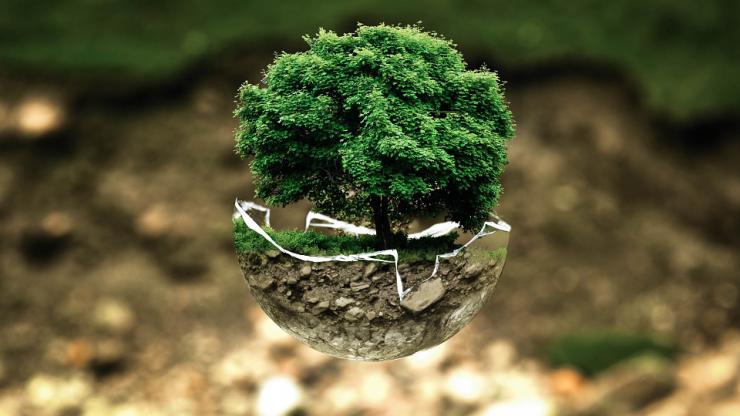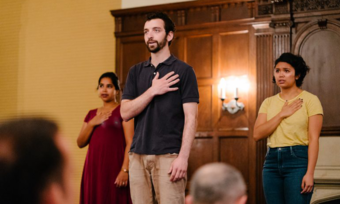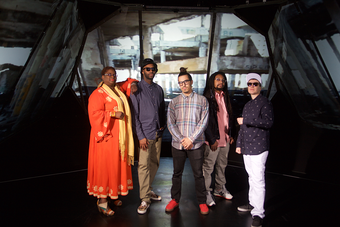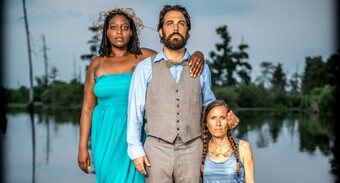The Aesthetic Evolution of Eco Theater
Eco theater’s modern aesthetic began not in theater, but with the conservationist and naturalist writers of the nineteenth century. It can be argued that Henry David Thoreau, John Ruskin, William Morris, Edward Carpenter, and their contemporaries radically redefined our conceptual relationship to the natural world. They sought to achieve not merely a balance with nature, but a reverence and subjugation to it. These writers and other conservationist and naturalist authors, artists, and politicians led in large part to the formation of our national parks and first environmental legislation. Later theorists and artists in theater and literature have come to call this early writing and the later work inspired by it, ecocriticism. This history inspired the first eco theater artists at a time when there was no global warming, no Greenpeace, and no firm scientific understanding of pollution and its deleterious effects. These artists were working from a phenomenological, environmental, and ethical understanding of our relationship to the natural world. The first pieces of eco theater are not always seen as centered on ecological issues, but rather view ecological issues from a social, economic, and ethical perspective.
These artists were working from a phenomenological, environmental, and ethical understanding of our relationship to the natural world.
The first modern eco theater plays put the natural world in conversation with human socio-economic concerns in the context of interpersonal relationships. Luminaries of the field have credibly claimed many modern classics as salient examples of early eco theater. Una Chaudhuri and others have explored and confirmed the eco-centered nature of Ibsen’s An Enemy of the People, The Federal Theater Project’s Living Newspaper plays Power and Triple A-Plowed Under, Robert Schenkkan’s The Kentucky Cycle, August Wilson’s Two Trains Running, Albee’s The Goat, or who is Sylvia?, David Edgar’s Continental Divide, and even Miller’s Death of a Salesman.
As a codified artistic movement eco theater began in the mid 1980’s though its beginnings can be traced to the 1970’s and earlier. These first self-proclaimed eco theater artists acted out of political disillusionment with large corporations, environmental dangers, and existing social structures. These artists addressed a specific issue at a specific place and time. The concerns ranged from pesticide use, to waste dumps in lower-class urban areas, to deforestation. I would also include artists and groups such as Bread and Puppet Theater and other theater groups that sought to alter the very way we interact with the environment, not merely inform us of the evils of styrofoam. A feature of this early wave is its discussion of ecological issues as more inclusive of other forms of oppression; racism, repression of the lower class, immigration policies, imperialism, and state aggression.
Heroes and Saints by Cherrie Moraga dramatizes the effects of pesticides on the physical and spiritual body with the use of lyrical realism based on real events that happened in McFarland, California. Similarly, La Quinceanera by Teatro Nuestro displayed the effects of pesticide use in comedic melodrama, featuring “El Pesticido” as a large masked deathlike apparition. Again, the work was a response to local events. Before creating the work, Teatro Nuestro held forums researching specific incidents to create a working draft. Before a final version was made, they returned to these same communities seeking feedback. Taking an aggressive approach in performance “La Quinceanera [went] directly to the farm labor camps with audiences coming right out of the fields.” Considered extremely successful, the play was seen as influential to later local organizing on the issue of pesticides and community safety.
This concern for the implications of ecological negligence, and the direct approaches taken to address them, inspired artists to make the process of theater itself ecologically sound. This environmental movement within theater features stalwart innovators that refuse to compromise in their demand for viable, interesting, and ecologically neutral theater.
This wave features purists such as Tanja Beer, Superhero Clubhouse, and the Earth Matters on Stage (EMOS) Festival that have created an integrated ecological practice: full length plays that put the natural world in conversation with the human socio-economic concerns, and do so with productions that practice sustainability.
In her words, “Theatrical storytelling doesn't need to cost the earth.”
Tanja Beer uses clear designs with ambitious goals to transform ecological concerns into theatrical options. She seeks to integrate green design practices from the start. In her words, “Theatrical storytelling doesn't need to cost the earth.” Innovative examples of her work include a fully reusable and edible set, a “living stage,” and working with found material. Her work is an important landmark in the evolution of eco theater. It shows theater creators that ecologically viable theater need not focus solely on ecological issues. A production can use sustainable methods without being labeled a “hippie play.” With this approach eco theater becomes an advancement in the craft of theater creation akin to electric lighting, microphones, or the shift to realism.
Superhero Clubhouse exemplifies a similar shift. Eco theater as simply theater. It is not meant as a protest or an art installation at a climate change conference. It is a complete and independent artistic practice that happens to focus on ecological issues, in the same way that Oscar Wilde happened to write witty dramas of manners. Treating the choice to focus on eco theater as artistically obvious and socially viable forces the question: why aren’t other artists engaging with eco theater? Their broad approach is a long delayed response to Una Chaudhuri’s call to arms asking theater to respond to the ecological crisis. They answer the call through work with fifth grade students to create eco theater plays, site specific pieces with climate scientists that include original songs, and productions of full length pieces. Superhero Clubhouse has not only created usable, direct, and personal awareness to inspire action. They have enlisted an engaged audience, and a community of artists, actors, playwrights, and producers that see eco theater as valid, needed, and part of the theatrical tradition. In the process they are creating an eco cannon that was considered woefully missing only a short time ago.
The EMOS Festival founded by Theresa May represents a melding of several artistic trends within eco theater. While the plays remain the biggest draw and the best way to interact with the general public, the true power of EMOS lies in its academic engagement. The panels and presentations are dynamic and relevant. They start a dialogue on diverse and salient topics such as sustainable design and offer workshops that put theories into practice. This creation of academic interest and material leads to the formation of courses, academic productions, resources, and full-fledged programs in eco theater. The California Institute of the Arts, University of Oregon, University of Indiana, and York University have all brought sustainability into their theatrical curriculum and practice. York University now offers a Master of Fine Arts Degree in Sustainable Design.
May and her work were born from the aesthetic of Bread and Puppet theater and other environmental theater groups that sought to re-define our relationship to the world on a philosophical level rather than on a carbon footprint level. In this way EMOS, and Professor May specifically, act as a sort of aesthetic bridge; allowing the ethical, cathartic, and metaphysical implications of our ecological crisis to combine with the hard sciences, social pragmatism, and economic incentives.
The impact of eco theater can be seen in obvious concrete ways, but also in subtle changes in aesthetic. Theaters as organizations now look for ways to show ecological concern. The LEED Platinum certification of the Portland Center Stage building is a perfect example. Academic programs have coalesced offering courses and degrees in eco theater. The greatest change is that now ecological concern is commonplace and in some settings even expected. The Lion King displays the need for ecological balance as its central theme, Continental Divide asks us to consider the effects and needs of ecological and political activism, and The Goat, or Who is Sylvia? examines the ever blurring lines between the human and natural world. No longer a rarified campaign of the outcasts, eco theater has been taken up by the theatrical establishment as a viable aesthetic.
Eco theater has altered our perceptions, our assumptions, and our culture. We understand that we live in a finite and mortal ecosystem, knowledge of human impact on the environment and global climate change have become hallmarks of even a marginally informed and aware person, and eco theater is becoming a more powerful force in our theatrical practice.
***
Works Consulted:
Arons, Wendy, and Theresa J. May, eds. Readings in Performance and Ecology. Basingstoke: Palgrave Macmillan, 2012.
Beer, Tanja. "Tanja Beer: Design Portfolio." Tanja Beer: Design Portfolio. N.p., n.d. Web. 15 Aug. 2013. <http://www.tanjabeer.com/>.
Cheever, Susan (2006). American Bloomsbury: Louisa May Alcott, Ralph Waldo Emerson, Margaret Fuller, Nathaniel Hawthorne, and Henry David Thoreau; Their Lives, Their Loves, Their Work. Detroit: Thorndike Press. Large print edition.
Cless, Downing. “Eco-Theater, USA: The Grassroots Is Greener.” TDR 40.2 (1996): 79-102.
"Earth Matters on Stage Ecodrama Festival." Earth Matters on Stage Ecodrama Festival. N.p., n.d. Web. 15 Aug. 2013. <http://emosfestival.wordpress.com/>.
"Earth Matters on Stage." Earth Matters on Stage. University of Oregon, n.d. Web. 15 Aug. 2013. <http://pages.uoregon.edu/ecodrama/finalists/>.
"Ecodrama Playwrights Festival 2004 Winner and Finalists." Earth Matters On Stage. University of Oregon, Humboldt State University, 2004. Web. 15 Aug. 2013. <http://pages.uoregon.edu/ecodrama/2004/finalists.html>.
Fleming, James R.; Bethany R. Knorr. "History of the Clean Air Act". American Meteorological Society. <http://www.ametsoc.org/sloan/cleanair/> Retrieved 2006-02-14.
Gould, Peter C. (1988). Early Green Politics, Brighton, Harvester Press, pgs. 15-19,
Henry David Thoreau : A Week on the Concord and Merrimack Rivers / Walden / The Maine Woods / Cape Cod, by Henry David Thoreau, Library of America,
May, Theresa J. "Beyond Bambi: Toward a Dangerous Ecocriticism in Theater Studies." Theater Topics 17.2 (2007): 95-110. Print.
May, Theresa J. “Greening the Theater: Taking Ecocriticism from Page to Stage.” Interdisciplinary Literary Studies; New Connections in Ecocriticism 7.1 (2005): 84-103.
McEvilley, Thomas (2002). The shape of ancient thought: comparative studies in Greek and Indian philosophies. Allworth Press.
Pickard, Jeremy. "On Eco-Theater." TCG Circle On EcoTheater Comments. Theater Communications Group, June 2013. Web. 15 July 2013. <http://www.tcgcircle.org/2013/06/on-eco-theater/>.
Ponomarev, Leonid Ivanovich (1993). The Quantum Dice. CRC Press.
Register, National. "History and Culture." National Parks Service. National Parks Service, n.d. Web. 15 Aug. 2013. <http://www.nps.gov/yose/historyculture/index.htm>
"Schedule Of Events." Earth Matters on Stage Ecodrama Festival. Carnegie Mellon University, n.d. Web. 15 Aug. 2013. <http://emosfestival.wordpress.com/2012-festival-symposium/schedule-of-events>.
"Superhero Clubhouse - About." Superhero Clubhouse - About. N.p., n.d. Web. 15 Aug. 2013. <http://www.superheroclubhouse.org/about.html>.
“‘There Must Be a Lot of Fish in That Lake’: Toward an Ecological Theater” Theater 25.1 (1994): 23-31.
Wall, Derek, (1994) Green History: A Reader. London, Routledge, pgs. 9-14.









Comments
The article is just the start of the conversation—we want to know what you think about this subject, too! HowlRound is a space for knowledge-sharing, and we welcome spirited, thoughtful, and on-topic dialogue. Find our full comments policy here
Thanks for this article.
You may be interested in the rich diversity of work in the field of Performance and Ecology happening in the UK.
As a researcher and artist working in the field of Performance and Ecology, I personally find the term ‘eco theatre’ or ‘eco theater’ outmoded; it is does not represent the current breadth of working happening around these themes, especially the work happening outside of “conventional” theatre spaces. The field, which I feel is more accurately termed Performance and Ecology or Ecological Performance, includes not only ecocriticism as you suggest, but also site-specific work offering an experience of the material environment (ie. NVA), cycling shows or bike powered shows (ie. FanSHEN, Townley and Bradby), community-engaged performances (Multi-Story Water), immersive performance (Arbonauts), walking performances (Jess Allen’s work), eco-activism as performance (see Sarah Standing’s writing and PLATFORM) and intermedial performance (Fevered Sleep) - and there are many more!
EMOS broke ground by establishing an academic dialogue but there are a number events and publications that have built on EMOS and helped developed the discourse. It would have been great to see some of the more recent publications referenced here including Performing Nature (Giannachi and Stewart eds), Performance Research journal 2012 edition ‘On Ecology’ and Research in Drama Education 2012 journal edition on ‘Environmentalism’ (to name only a few!). There are also a number of research networks that have had a big influence of the field: Performance Footprint Network (http://performancefootprint... ) and more recently More than Human Participatory Research (http://www.morethanhumanres...) and Walking Interconnections (http://walkinginterconnecti...) as well as the amazing Ashden Directory (http://www.ashdendirectory....). Again, this is only a selection.
I would like to see much more dialogue between countries in order to develop the field even further as there is also really interesting work going on in Canada and Australia and I’m sure other parts of the world as well. In order to truly establish an ecological aesthetic in performance, the field needs to be developed as a whole rather than in isolated geographical areas.
I am currently working on a PhD on the aesthetics of ecological performance (performanceandecology.wordp...) and make work with my company Green Stage (greenstagetheatre.co.uk) and Plantable Performance Research Collective and Tanja Beer. EMOS, thankfully, provided an opportunity for me to meet academic and artistic collaborators interested in the intersection of ecology and performance. We live in different countries but are able to collaborate remotely (and sometimes in person).
Those interested in joining an international community of researchers, partitioners and artists may want to join the Performance and Ecology Listserv: lists.performanceandecology...
I am very happy to read the comment by Karen Malpede about the often ignored history of ecological performance in relation to eco-feminism. Karen - are there any publications that have documented this work that you could point me to?
Many thanks,
Lisa Woynarski
This is a good article as far as it goes, but I'd like to add a few observations (Chekhov, Euripides as eco-dramatists, too), and some additional recent history. There was a vibrant eco-feminist movement in the country in the 1980s, led by Ynestra King and Grace Paley: they (we, as I was also a part, along with Dorothy Dinnerstein, and many other feminists, Bella Abzug, Barbara Deming, etc.) wrote the Women and Life on Earth statement and at the same time organized: the Women's March on the Pentagon (there were 2 of them) a combination of collective ritual, performance art and civil disobedience. We also organized the Women's Peace Encampment at Seneca Falls--an eco feminist camp that engaged in regular civil disobedience and eco-performance art at the nuclear base in the summer of 1984--as part of a world-wide anti-nuclear movement. At the same time, at NYU's Undergraduate drama dept, I was teaching Ecology and Theater courses and creating in 1991, the Kassandra project, an eco-feminist play based upon Christa Wolf's great novel of the same name. Among the students who were permanently influenced by the Ecology and Theater classes they took with me is the great singer/musician Antony, of Antony and the Johnsons--then a student whose eyes were suddenly opened to the eco-feminism that still infuses his work. Nonviolence, the need to end nuclear proliferation and to save the earth were linked issues in the movement and in my classes and in the Kassandra production--which was done on a stage of sand, with an altar light, and lighting that moved across the stage as the sun moves across the sky. It was directed by the great Greek classical actress, Lydia Koniordou. We accompanied the performances with a Kassandra symposium. A few years earlier, in 1989, my eco-drama "Better People" was produced at Theater for the New City--featuring the first major puppet by the now master puppeteer Basil Twist. This was a Yak who refused to cloned and, instead swallows a geneticist, played by George Bartenieff, who emerges as an ecologist, committed to preserving all species in their natural states. Again, we hosted many symposia with scientists and environmentalists. Now, my theater company Theater Three Collaborative is producing my new play "Extreme Whether" which includes the latest science about climate change in a hot family feud drama that evokes "Enemy of the People". I write this because academics like Una Chaudhuri seem unaware of this history of eco-feminist performance and protest that predates their theoretical work.
we are raising money for a terrific new eco-drama "Extreme Whether" . View our video with Drs. James Hansen and Jennifer Francis, and the late, great eco activist Father Paul Mayer, and clips from the play:
www.indiegogo.com/projects/...
Bravo, Dillon!
I am a playwright who once upon a time was a biologist. I am writing the book right now, for a musical about extractive economy. The play is Coal: Fable of the Firerock, (read more about it on my website under projects and collaborations) and through it, we hope to activate the imaginations and the motivational engine of communities around the country to take eco-responsibility. We are working alongside a strong engagement team and with collaborators from across the country.
Though my writing is what the field calls "Theatre for Young Audiences" I think there's more to it. My focus is on animals, nature and the natural and on telling the stories of sustainability. I am hoping that I can unearth values and buried rituals that can give way to a new genre or way of thinking for the dramatic artists/writers of the Americas.
I brought this up at the recent Latino Commons Conference. I mentioned how I felt it important that a community, like the Latino Community, should have the conversations about becoming more than a social entity, but rather a collective group creating stories of sustainability and of our connection to the natural.
I am happy to read this post. And encourage you to contact me if you are interested. We are a growing project (Coal) always looking for new voices, and, just personally, I would be very interested in meeting you...
Thanks again for this.
It's "Chaudhuri" not Chandri, please correct!
corrected, thank you!